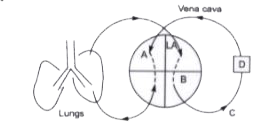Lungs receive blood from right side of the heart, whereas the branching of systemic arteries result in a parallel pattern. What is the advantage of such of an arrangement ?
It ensures that each of the peripheral organs and tissues receive only a fraction of blood pumped by the left ventricle
It allows for independent variation in blood flow through different tissues as their metabolic activities change
It ensures that as blood flows through capillariesm some of the oxygen leaves the blood to enter cells
Both (a) and (b)
The correct Answer is:D
The lungs receive all the blood pumped by the right side of the heart, whereas the branching of the systemic arteries results in a parallel pattern so that each of the peripheral organs and tissues receives only a fraction of the blood pumped by the left ventricle. This arrangement guarantees that all systemic tissues receive freshly oxygenated blood and allows for independent variation in blood flow through different tissues as their metabolic activies change.
Topper's Solved these Questions
- BOOK - NCERT FINGERTPS ENGLISHCHAPTER - BODY FLUIDS AND CIRCULATIONEXERCISE - EXEMPLAR16videos
BODY FLUIDS AND CIRCULATION
- BOOK - NCERT FINGERTPS ENGLISHCHAPTER - BODY FLUIDS AND CIRCULATIONEXERCISE - CORNER1videos
BODY FLUIDS AND CIRCULATION
- BOOK - NCERT FINGERTPS ENGLISHCHAPTER - BODY FLUIDS AND CIRCULATIONEXERCISE - Body Fluids And Circulation151videos
BODY FLUIDS AND CIRCULATION
- BOOK - NCERT FINGERTPS ENGLISHCHAPTER - BIOMOLECULESEXERCISE - Biomolecules137videos
BIOMOLECULES
- BOOK - NCERT FINGERTPS ENGLISHCHAPTER - BREATHING AND EXCHANGE OF GASESEXERCISE - Breathing And Exchange Of Gases140videos
BREATHING AND EXCHANGE OF GASES
Similar Questions
A beam of light of wavelength 600 nm from a distant source
falls on a single slit 1.0 mm wide and the resulting diffraction pattern is
observed on a screen 2m away. What is the distance between the first dark
fringe on either side of the central bright fringe?View SolutionA beam of light of wavelength 600 nm from a distance source falls on a single slit 2 mm wide and the resulting diffraction pattern is observed on a screen 2m away. What is the distance between the first dark fringes on either side of central bright fringe ?
View Solution
Knowledge Check
- Question 1 - Select One
A beam of light of wavelength 600 nm from a distant source
falls on a single slit 1.0 mm wide and the resulting diffraction pattern is
observed on a screen 2m away. What is the distance between the first dark
fringe on either side of the central bright fringe?A1.2cmB1.2mmC2.4cmD2.4mm - Question 2 - Select One
Read the following statements carefully
(i) In fishes, the heart pumps out deoxygenated blood which is oxygenated by the gills and supplied to the body parts from where deoxygenated blood is returned to the heart.
(ii) The openings of the right and the left ventricle into pulmonary artery and aorta respectively are provided with the mitral valves.
(iii) The nodal musculature has the ability to generate action potential without any external stimuli, i,e., it is autoexcitable.
(iv) The T-wave of ECG represents depolarisation of the ventricles.
Which of the above four statements are incorrect?A(i) and (ii)B(ii) and (iv)C(i) and (ii)D(iii) and (iv)
A beam of light of wavelength 600 nm from a distant source falls on a single slit 1.0 mm wide and the resulting diffraction pattern is observed on a screen 2 m away What is the distance between the second bright fringe on either side of the central bright fringe ?
View SolutionEight point charges of magnitude Q are arranged to form the corners of a cube of side L. The arrangement is made in manner such that the nearest neighbour of any charge has the opposite sign. Initially, the charges are held at rest. If the system is let free to move, what happens to the arrangement? Does the cube-shape shrink or expand? Calculate the velocity ct each charge when the side-length of the cube formation changes from L to nL. Assume that the mass of each point charge is m.
View SolutionRight atrium of heart of mammal receives blood from
View SolutionGiven alongside a schematic representation of the circulatory system in man. Study the same and answer the question that follows.

What is the specific name of the type of blood circulation that takes place between the heart and lungs?View Solutiona. Amphibians and reptiles have a 3 chambered heart with ___ atria and ___ventricle.
b. Heart is ___ derived organ and protected by a double walled membranous bag called ____
c. The opening between right Atrium and Right ventricle is guarded by a valve formed of ___ muscular flaps, the ___ valve.
d. The wall of ventricle is ____ than atria.
e. SAN can generate the maximum number of action potential i.e., ____ min−1. therefore it is called _____
f. Atrial systole increases the flow of blood into the ventricles by about ____ percent.
g. In ____ all the four chambers of the heart are in a relax state.
h. The ____ wave represents the depolarisation of the atria.
i. A system of blood vessels is present in our body exclusively for the circulation of blood to and from the cardiac musculature called _____
j. PNA ____ the rate of heart beat and ______View SolutionA beam of light of wavelength 600 nm from a distance source falls on a single slit 1 mm wide and resulting diffraction pattern is observed on a screen 2m away. What is the distance between the first bright fringes on either side of the central bright fringe ?
View Solution
